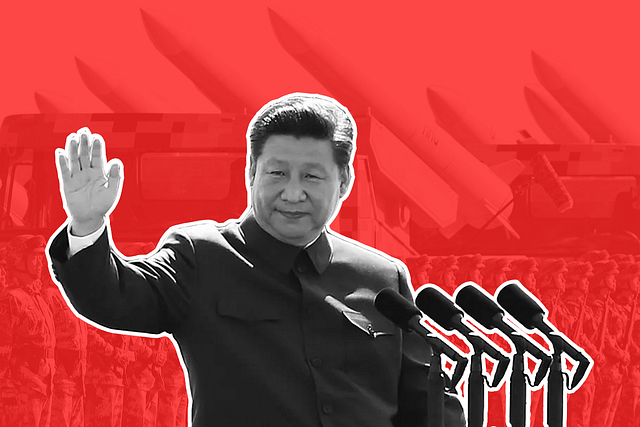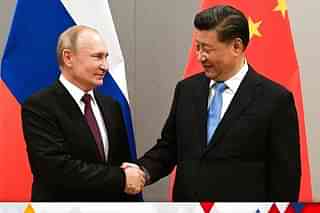World
Explained: Why China Has Split Its Strategic Support Force Formed To Win Future Wars
Ujjwal Shrotryia
Apr 23, 2024, 06:35 PM | Updated 06:35 PM IST
Save & read from anywhere!
Bookmark stories for easy access on any device or the Swarajya app.

China has dissolved its shadowy Strategic Support Force (SSF) and split it into three different entities — the Information Support Force (ISF), the Cyberspace Force, and the Aerospace Force.
The SSF, established in 2015, was part of a series of wide-ranging reforms in the People's Liberation Army (PLA) that were meant to increase the PLA’s combat effectiveness and prepare it for future conflicts.
Under the 2015 reforms, the seven military districts of the PLA were consolidated into five theatre commands, the PLA Second Artillery Corps was reconstituted as the People's Liberation Army Rocket Force (PLARF), and the SSF was created.
Its primary job was to integrate all branches of the PLA — the army, navy, air force, near-space, and cyber — into a single cohesive unit that would be able to plan and execute joint operations to achieve a given objective.
Now, the disbandment of the SSF comes just eight years after its formation — a very short time for such a young organisation to even begin to bear fruit or show actual results — hinting at other reasons behind its dissolution.
It has been split into three different entities, a level below the PLA Army, Navy, Air Force, Rocket Force, and the five theatre commands in the Chinese hierarchy.
The three different entities, the Information Support Force, the Cyberspace Force, and the Aerospace Force, are meant to make the PLA and its commanders ready for future conflicts.
President Xi Jinping, after the establishment ceremony in Beijing, emphasised that the “ISF is a new strategic branch of the military and a key pillar in coordinating the construction and application of the network information system.”
The ISF will be directly commanded by the Central Military Commission (CMC).
The exact roles of the ISF were not identified in the announcement, but it is expected that this force will be key in managing and winning the information domain, which is core to the ‘three dominances’, viz, information, air, and space warfare.
This entails complete control over the enemy’s flow of information to achieve rapid victory while ensuring that the information flow of one's own forces is not compromised.
The Cyberspace Force, on the other hand, is supposed to disrupt the enemy’s critical infrastructure, including its command and control networks, using cyber attacks and hacking.
Meanwhile, the Aerospace Force will manage all the space assets of the PLA.
It will disrupt the enemy’s space-based communications and GPS-based activities using anti-satellite (ASAT) weapons, including directed energy weapons (DEW), such as lasers, and disrupt the flow of signals between satellites and mobile receivers using jamming from mobile electronic warfare equipment.
In contrast, the SSF, with its two departments, the Space Systems Department and Network Systems Department, handled all space-related operations including space domain awareness and anti-satellite missions, and all cyber, electronic warfare (EW), and psychological operations, respectively, integrating all of them under SSF.
The SSF would have used cutting-edge artificial intelligence and machine learning (AI/ML) algorithms to collate and analyse thousands of gigabytes of data coming from all PLA sea, air, land, undersea, and space-based sensors, in real-time, to suggest future courses of action to senior commanders in the CMC and in the field.
Perhaps this may be the reason for trifurcating the SSF into three different entities.
This amount of consolidation of information under a single entity may have had the potential to threaten Xi and his control over China.
Already, President Xi is on a purging spree, relieving high-ranking officers from their commands who were either linked to corruption or were in his opposition.
Last year, China’s forces went through purges of high-ranking officials and commanders who were accused of graft and corruption. Both the Foreign Minister, Qin Gang, and Defence Minister General Li Shangfu were unceremoniously shunted from their positions.
On top of it, there were reports (January 2024) that there was widespread corruption in the PLARF, which raised doubts over the combat potential of the PLARF.
Realising that whoever has control over all this information has the potential to threaten Xi’s one-man control over China, the Chinese President may have found it worthwhile to dilute the SSF into three separate organisations that can remain subservient to him.
This is given further credence by the fact that the ceremony noted, “We must resolutely listen to the Party's command, fully implement the fundamental principles and systems of the Party's absolute leadership over the military, comprehensively strengthen Party building in the military, strengthen ideals and beliefs, strictly enforce discipline and rules, promote good work styles, and ensure the absolute loyalty, purity, and reliability of the military.”
Whether this will adversely or favourably impact the combat potential of the PLA remains to be seen.
Save & read from anywhere!
Bookmark stories for easy access on any device or the Swarajya app.
Staff Writer at Swarajya. Writes on Indian Military and Defence.
Support Swarajya's 50 Ground Reports Project & Sponsor A Story
Every general election Swarajya does a 50 ground reports project.
Aimed only at serious readers and those who appreciate the nuances of political undercurrents, the project provides a sense of India's electoral landscape. As you know, these reports are produced after considerable investment of travel, time and effort on the ground.
This time too we've kicked off the project in style and have covered over 30 constituencies already. If you're someone who appreciates such work and have enjoyed our coverage please consider sponsoring a ground report for just Rs 2999 to Rs 19,999 - it goes a long way in helping us produce more quality reportage.
You can also back this project by becoming a subscriber for as little as Rs 999 - so do click on this links and choose a plan that suits you and back us.
Click below to contribute.





